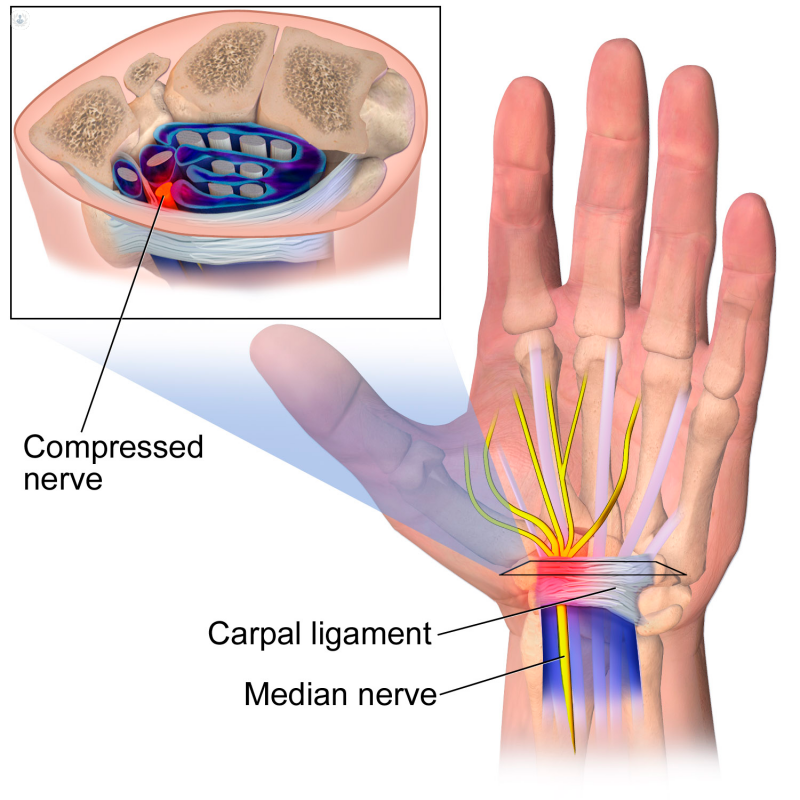Median nerve
Mr Philip Mathew - Orthopaedic surgery
Created on: 03-04-2014
Updated on: 03-30-2023
Edited by: Carlota Pano
What is the median nerve?
The median nerve is one of the nerves in your arm, extending into the hand. It is the only nerve which passes through the carpal tunnel, one of the passageways that connects the hand to the forearm.
The median nerve controls the function and feeling in most of the fingers in your hand, as well as part of your palm. The only fingers the median nerve does not control is the little finger and part of the ring finger, which are controlled by the ulnar nerve. The radial nerve is also responsible for some sensation in the hand.

How does the median nerve help us?
The median nerve serves both motor and sensory functions in the forearm, wrist and hands. The median nerve begins in the underarm, but its functions take place in the hand or forearm.
The median nerve helps us to: bend and straighten our wrists, thumbs and first three fingers, as well as rotate our forearms and rotate our hands in order to turn the palm downward.
The median nerve also serves pain, touch and temperature sensations in the:
- Forearm
- Palm (bottom) side of the thumb, index and middle fingers, and part of the ring finger
- Thumb side of the palm
- Nail bed (top) side of the index and middle fingers
How can the median nerve become injured?
The two most common places for the median nerve to become damaged or compressed are at the elbow and at the wrist.
A number of elbow injuries can affect the median nerve, including a fracture or a dislocation. A pinched nerve (nerve entrapment) or neuroptahy (nerve damage) can occur as a result of pressure on the median nerve.
There are other various conditions which develop as a result of pressure to the median nerve.
Pronator teres syndrome occurs in the pronator teres muscle, which is located near the elbow. It occurs when the median nerve is compressed at the elbow. This condition results in a dull, aching pain in the forearm and may also cause thumb and finger numbness, or paralysis. The condition is often caused by repetitive turning, grasping, and twisting of the hand and wrist, often involved in jobs that require heavy manual labour, weightlifting, or racket sports. It can also be caused by body abnormalities, a tumour, or scar tissue.
At the wrist, compression is known as carpal tunnel syndrome. Symptoms include finger pain, wrist pain and numbness. This is a common condition which tends to affect women more than men, but the exact cause is unknown.
Another condition related to median nerve damage is anterior interosseous nerve syndrome. The anterior interosseous nerve is a motor branch of the median nerve and can cause weakness or paralysis in the thumb and finger.
What are the symptoms of a median nerve injury?
Symptoms can vary depending on the injury. Compression on the nerve can cause pain, particularly at night, a tingling sensation in your fingers, numbness and weakness in the hand.
Fracture, trauma or dislocation that has caused damage to the nerve can also cause numbness or weakness. You might find it difficult to turn the hand over, grip things, or move the thumb across the palm. If the nerve has been severely damaged, this can lead to muscle wastage.
Diagnosis
Clinical presentation and a physical examination may be used to confirm diagnosis of median nerve compression with help of the Tinel’s sign and Phalen maneuver. Another manner to obtain a diagnosis is through splinting. This is one of the most common ways to diagnose median nerve injuries.
How is an injury to the median nerve treated?
When the median has been damaged by an acute injury at the elbow or wrist (such as a fracture or dislocation), the first line of treatment is to address the initial injury. Soft tissue injury can be treated with compression, applying ice, and keeping the arm elevated. A bone fracture which is unlikely to heal in the correct way, or which is putting pressure on the nerve, may require surgery.
Carpal tunnel syndrome can be treated very easily with carpal tunnel surgery. This is a quick procedure which releases space in the carpal tunnel for the median nerve, and provides immediate relief of symptoms.
Most treatment aims to prevent any further damage. Existing damage to nerves is likely to be permanent and you cannot always regain lost function or strength. Therefore it’s important to see an orthopaedic surgeon as soon as possible if you experience the symptoms above.
Traditional methods of diagnosis include yoga, physical therapy and therapeutic ultrasound. Therapeutic ultrasounds increase the rate of healing and also improve the quality of repair.
If patients suffer from pain for more than four to six months and do not experience relief from traditional methods, then they may undergo a surgical decompression.

How can I protect my median nerves?
In order to prevent median nerve damage you can take steps, such as:
- Improve your sleep habits
- Quit smoking
- Try to maintain a healthy weight through exercise and a nutritious diet
- Make lifestyle changes to improve conditions like diabetes and high blood pressure that can damage nerves
- Managing stress is key. In order to do this you can meditate, write in a journal or find other ways to cope with stress








